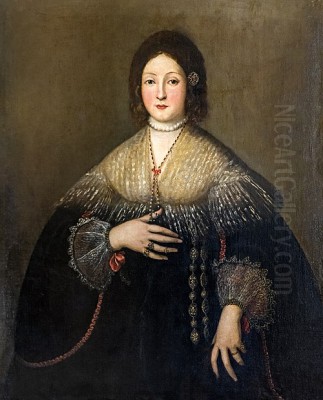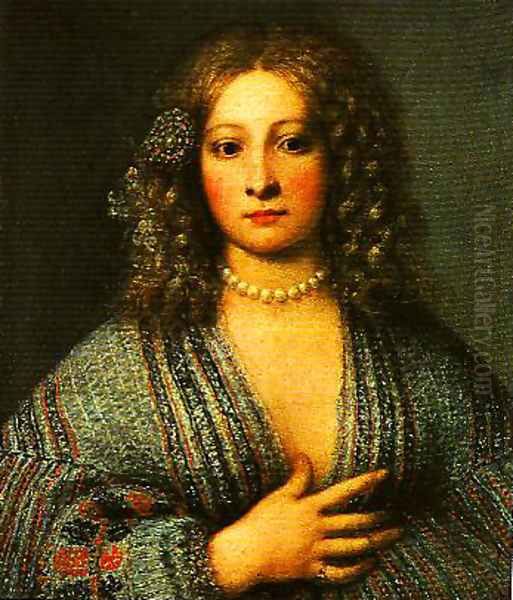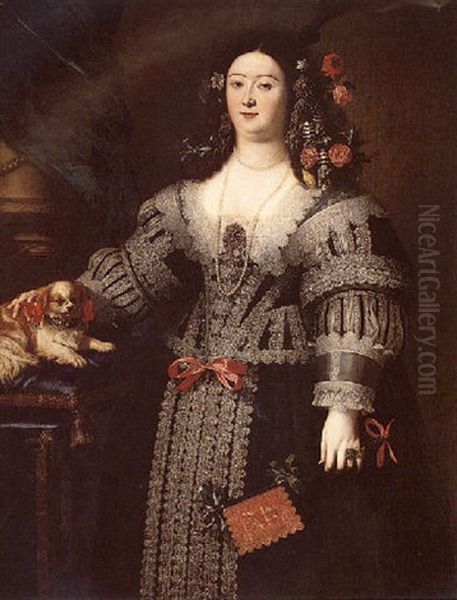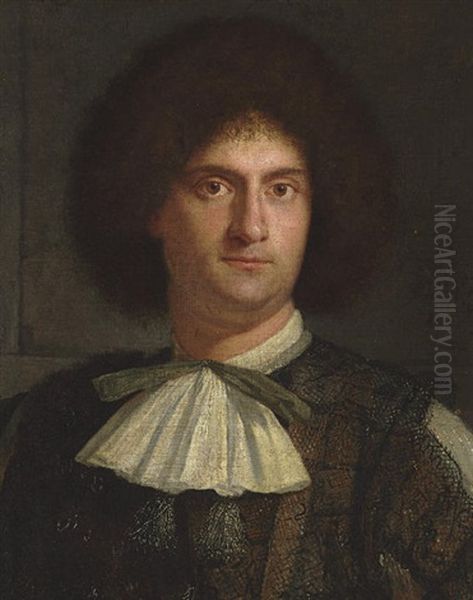
Girolamo Forabosco, also occasionally recorded as Ferabosco, stands as a significant figure in the vibrant artistic landscape of seventeenth-century Italy. Active predominantly in Venice and Padua, he carved a distinguished career primarily as a painter of portraits, though his oeuvre also includes compelling narrative and religious compositions. His work is characterized by a refined naturalism, an acute psychological insight into his sitters, and a painterly technique that masterfully blended Venetian traditions with emerging Baroque dynamism.
The Enigma of Dates and Early Formation
The precise chronology of Forabosco's life has been a subject of some scholarly debate. While certain older sources proposed a birth year around 1600 and a death in 1660, more extensive research and documentary evidence now strongly support his birth in Venice between 1604 and 1605, and his death in Padua in 1679. This revised timeline places him firmly within the flourishing artistic milieu of the Seicento, a period of rich artistic exchange and innovation in the Veneto region.
Born into the heart of the Venetian Republic, a city renowned for its unique artistic heritage, Forabosco would have been immersed in a visual culture shaped by titans of the Renaissance. The legacy of artists such as Titian (Tiziano Vecellio), with his profound understanding of color and human character, and Paolo Veronese, celebrated for his opulent and grand-scale narrative scenes, formed the bedrock of Venetian painting. The dramatic intensity and expressive power of Jacopo Tintoretto also left an indelible mark on the city's artistic consciousness. It was within this rich artistic environment that Forabosco's own talents began to germinate.
Early in his career, Forabosco appears to have absorbed influences from prominent contemporary figures. The painter Alessandro Varotari, known as il Padovanino, is often cited as a key influence. Padovanino himself was a fervent admirer and emulator of Titian, and his efforts to revive Titian's rich colorism and sensuous handling of paint likely resonated with the young Forabosco. This connection is evident in Forabosco's early works, such as the painting Menichina dated to 1624, which displays a sensitivity to texture and a warmth of palette reminiscent of Padovanino's style.

Another important figure in Forabosco's formative years was Tiberio Tinelli, a highly regarded portraitist in Venice. Tinelli was known for his elegant and psychologically astute portraits, often characterized by sophisticated compositions and a refined rendering of detail. It is believed that Forabosco learned much about compositional strategies and the formal presentation of sitters from Tinelli. This influence can be discerned in Forabosco's own approach to portraiture, particularly in his ability to convey the status and personality of his subjects through pose, attire, and subtle facial expression, as seen in works like his Portrait of a Woman.
A Career Divided: Padua and Venice
Forabosco's professional life unfolded across two major artistic centers of the Veneto: Venice, his birthplace, and Padua, a nearby city with a distinguished university and its own thriving artistic community. While he maintained a primary residence in Venice for much of his life, his connections to Padua were significant and well-documented.
Between 1634 and 1639, Forabosco was enrolled in the Fraglia dei Pittori, the painters' guild, in Padua. Guild membership was crucial for artists, providing a framework for professional practice, commissions, and the training of apprentices. His payment of taxes in Padua from 1640 to 1644 further attests to his active presence and professional establishment in the city during this period. This suggests that he likely maintained a workshop and undertook significant commissions there.
A notable period of focused activity in Padua occurred in 1653, when records indicate he established a studio in the city for approximately a year. This sojourn might have been prompted by specific commissions or a desire to engage more directly with Paduan patrons and artistic circles. Padua, while geographically close to Venice, possessed its own distinct cultural character, and artists often moved between the two cities, enriching the artistic dialogue of the region.
Despite these periods of activity in Padua, Venice remained Forabosco's principal base. The Serenissima, with its wealthy patrician families, powerful religious institutions, and international mercantile connections, offered unparalleled opportunities for artists, particularly portraitists. The demand for portraits to commemorate individuals, celebrate family lineage, and project status was substantial, and Forabosco's skills were well-suited to meet this demand.
Artistic Style: Venetian Naturalism and Baroque Flourishes
Girolamo Forabosco's artistic style is a compelling synthesis of Venetian naturalism and the burgeoning aesthetics of the Baroque. He inherited the Venetian tradition's emphasis on colorito (color and painterly application) over disegno (drawing and design), but he infused this heritage with a contemporary sensibility that valued psychological depth and a certain dramatic flair.

A hallmark of Forabosco's portraiture is the remarkable accuracy with which he rendered facial features. He possessed a keen observational skill, capturing not just a likeness but also a sense of the sitter's inner life and personality. This precision, however, was not cold or clinical. It was combined with a fluid and often luscious brushwork that brought a sense of vivacity and immediacy to his subjects. His handling of flesh tones is particularly noteworthy, often achieving a warm, luminous quality.
His compositions, while often adhering to established portrait conventions, demonstrate a sophisticated understanding of how to present the human figure with dignity and presence. He paid careful attention to the rendering of luxurious fabrics, intricate lace, and gleaming jewelry, details that not only added to the visual richness of his paintings but also served as important signifiers of the sitter's social standing.
While deeply rooted in the Venetian school, Forabosco's work also reflects the broader currents of the Baroque. This is evident in his dynamic use of light and shadow (chiaroscuro), which he employed to model forms, create a sense of volume, and enhance the dramatic impact of his compositions. There is often a sense of movement, whether implied in the turn of a head or the gesture of a hand, that lends an animation to his figures, distinguishing them from the more static representations of earlier periods.
The influence of artists like Bernardo Strozzi, a Genoese painter who was active in Venice from 1631, can also be considered. Strozzi's robust figures, rich impasto, and warm coloring contributed to the evolving Venetian Baroque style, and Forabosco would have been aware of his work. Similarly, the dramatic intensity found in the works of other Venetian contemporaries, such as Francesco Maffei, who pushed Venetian colorism towards a more expressive and sometimes eccentric dynamism, formed part of the artistic environment in which Forabosco operated.
Masterpieces and Notable Works
Among Girolamo Forabosco's extant works, several stand out as particularly representative of his skill and artistic vision. His most famous painting is arguably the Miraculous Rescue, a large-scale canvas executed in 1646. This work was commissioned by Giovanni Ventura Gualtieri in gratitude for his survival from a shipwreck and was destined for a religious institution, possibly the Church of Santa Maria Assunta or San Aponal in Venice.

The Miraculous Rescue is a remarkable piece that showcases Forabosco's ability to handle complex, multi-figure compositions with a sense of spontaneity and warmth. Unlike many religious narratives of the period that adhered strictly to iconographic conventions, Forabosco's painting feels less constrained by rigid narrative or overtly pious demands. Instead, it presents a vivid tableau of figures, their expressions and gestures conveying a range of emotions. The work is celebrated for its naturalism, the believable interactions between the figures, and the artist's characteristic combination of accurate facial depiction with a free, flowing brushstroke. It demonstrates his capacity to create monumental works that are both visually engaging and emotionally resonant.
In the realm of portraiture, Forabosco excelled. His Portrait of Doge Domenico Contarini, painted between 1659 and 1660, is a fine example of his official portrait style. The Doge, the chief magistrate and leader of Venice, is presented with the dignity and authority befitting his office, yet Forabosco also manages to imbue the likeness with a sense of individual character. The meticulous rendering of the Doge's ornate robes and the symbols of his power are typical of Forabosco's attention to detail.
The Contarini family was a prominent patrician clan in Venice, and Forabosco appears to have enjoyed their patronage, producing several portraits for them. Similarly, he is known to have worked for other noble families, such as the Donà. These commissions underscore his reputation as a sought-after portraitist among the Venetian elite.
Beyond these grander commissions, Forabosco also produced more intimate portraits, often of unidentified sitters, which nonetheless display his characteristic sensitivity and skill. His female portraits, in particular, are often admired for their elegance and the subtle way in which he captures the sitter's gaze and demeanor. Works simply titled Portrait of a Woman or genre-inflected pieces like Menichina (if indeed a portrait rather than an idealized type) reveal his versatility in approaching the human subject. He also received commissions for religious works beyond the Miraculous Rescue, including an altarpiece for Patriarch Federico Cornaro, another influential figure in Venetian society.
Forabosco's Network: Patrons, Peers, and Pupils
An artist's career is shaped not only by their individual talent but also by their network of relationships, including patrons, fellow artists, and students. Forabosco was well-integrated into the artistic and social fabric of Venice and Padua.
His patrons, as mentioned, included some of the most powerful families and individuals in Venice, such as the Contarini, Donà, and Patriarch Federico Cornaro. Such patronage was vital, providing financial support and opportunities for significant commissions that would enhance an artist's reputation. The ability to secure and maintain these relationships speaks to Forabosco's skill not only as a painter but also as a professional navigating the complex social hierarchies of the time.
In the artistic community, Forabosco was a respected figure. His connections with artists like Alessandro Varotari and Tiberio Tinelli in his formative years were crucial. While direct evidence of close friendships or rivalries is often scarce in historical records, it is clear he operated within a competitive yet interconnected artistic environment. He would have been aware of the work of other leading painters in Venice, including those who, like him, specialized in portraiture or contributed to the evolving Baroque style. The influence of earlier Venetian masters like Giorgione, whose enigmatic and poetic style laid some of the groundwork for Titian's achievements, was part of the deep historical consciousness of Venetian artists. Later figures of the Venetian school, such as Palma Giovane, who was active into the early part of Forabosco's career, continued to develop the Venetian tradition.
Forabosco also played a role in shaping the next generation of artists. He is documented as having taught several pupils who went on to achieve recognition. Among the most notable was Gregorio Lazzarini. Lazzarini became a highly respected painter in Venice, known for his refined style and his own role as a teacher (his most famous pupil being Giovanni Battista Tiepolo). Forabosco's instruction would have provided Lazzarini with a solid grounding in Venetian technique and the principles of composition.
Other artists associated with Forabosco as students or followers include Francesco Rosa and Pietro della Vecchia. Pietro della Vecchia, in particular, developed a distinctive style, often characterized by his interest in genre scenes, pastorals, and sometimes bizarre or grotesque figures, but his early training would have exposed him to Forabosco's more classical and naturalistic approach. The painter Pietro Bellotti, known for his highly realistic and often characterful portraits of ordinary people, also shows stylistic affinities that suggest an awareness of, if not direct tutelage under, Forabosco, particularly in the detailed rendering of physiognomy and texture. The source material also mentions a "Biagio Maestro" as a possible competitor, though this figure remains more obscure in broader art historical accounts.
Art Historical Significance and Lasting Influence
Girolamo Forabosco occupies an important position in the art history of seventeenth-century Venice. He was a key figure in the continuation and evolution of the Venetian School, particularly in the domain of portraiture, during a period that saw the transition from late Renaissance sensibilities to the full flowering of the Baroque.
His primary contribution lies in his ability to synthesize the rich coloristic tradition of Venetian painting with a new emphasis on psychological naturalism and Baroque dynamism. In his portraits, he moved beyond mere likeness to explore the character and status of his sitters, employing a refined technique that captured both external appearance and an intimation of inner life. His work provided a sophisticated model for portraiture that was both elegant and insightful.
Forabosco's influence extended through his students, most notably Gregorio Lazzarini, who became a leading academic painter in Venice and a crucial link to the Rococo splendors of Tiepolo. By transmitting the core tenets of Venetian painting – the primacy of color, the expressive potential of brushwork, and the importance of capturing light – Forabosco helped ensure the continuity of this distinguished artistic lineage.
His religious and narrative works, such as the Miraculous Rescue, demonstrate his capacity for large-scale composition and his ability to infuse traditional subjects with a sense of immediacy and human warmth. These works show him engaging with the broader European Baroque interest in dramatic storytelling and emotional engagement, albeit filtered through a distinctly Venetian lens.
In the grand narrative of Italian art, Forabosco may not have achieved the revolutionary status of a Caravaggio or a Bernini, nor the towering fame of his Venetian predecessors like Titian or Veronese. However, his consistent quality, his influential role as a teacher, and his significant body of work, particularly in portraiture, mark him as a distinguished master of his time. He successfully navigated the artistic currents of the Seicento, creating a body of work that remains admired for its technical finesse, its perceptive portrayal of humanity, and its embodiment of the enduring allure of Venetian painting. His legacy is that of an artist who skillfully upheld and enriched a great tradition, leaving a valuable imprint on the art of his era and providing a crucial bridge to subsequent generations of Venetian painters.